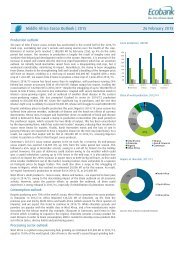www.ebook777.com
Make_Getting_Started_with_Processing_Second_Edition
Make_Getting_Started_with_Processing_Second_Edition
You also want an ePaper? Increase the reach of your titles
YUMPU automatically turns print PDFs into web optimized ePapers that Google loves.
float[] x = {-20, 20};<br />
void setup() {<br />
size(240, 120);<br />
noStroke();<br />
}<br />
void draw() {<br />
background(0);<br />
x[0] += 0.5; // Increase the first element<br />
x[1] += 0.5; // Increase the second element<br />
arc(x[0], 30, 40, 40, 0.52, 5.76);<br />
arc(x[1], 90, 40, 40, 0.52, 5.76);<br />
}<br />
Repetition and Arrays<br />
The for loop, introduced in “Repetition” on page 40, makes it<br />
easier to work with large arrays while keeping the code concise.<br />
The idea is to write a loop to move through each element of the<br />
array one by one. To do this, you need to know the length of the<br />
array. The length field associated with each array stores the<br />
number of elements. We use the name of the array with the dot<br />
operator (a period) to access this value. For instance:<br />
int[] x = new int[2];<br />
println(x.length);<br />
// Declare and create the array<br />
// Prints 2 to the Console<br />
int[] y = new int[1972]; // Declare and create the array<br />
println(y.length); // Prints 1972 to the Console<br />
Example 11-8: Filling an Array in a<br />
for Loop<br />
A for loop can be used to fill an array with values, or to read the<br />
values back out. In this example, the array is first filled with random<br />
numbers inside setup(), and then these numbers are used<br />
to set the stroke value inside draw(). Each time the program is<br />
run, a new set of random numbers is put into the array:<br />
Arrays 155



